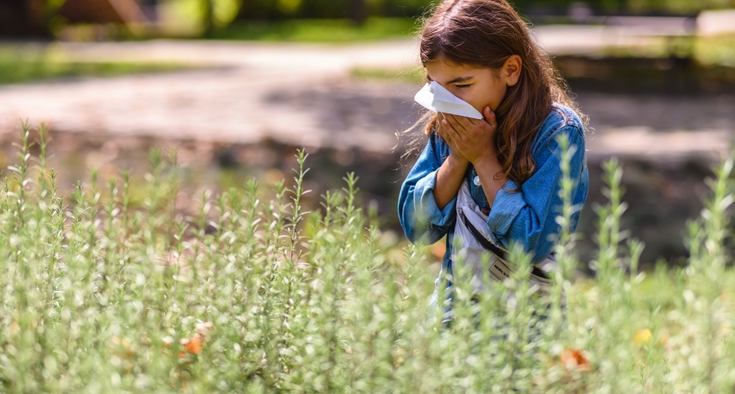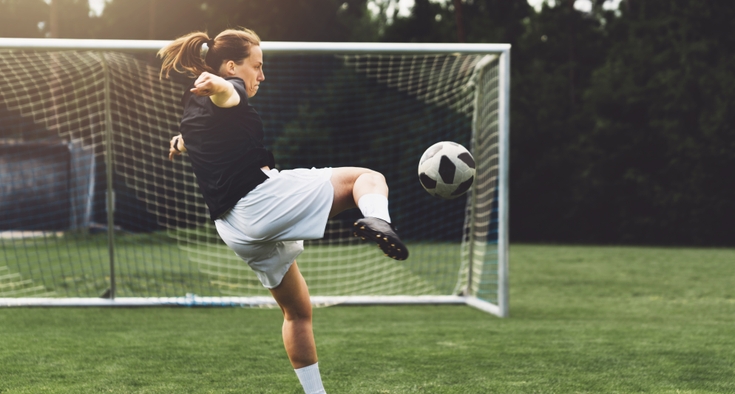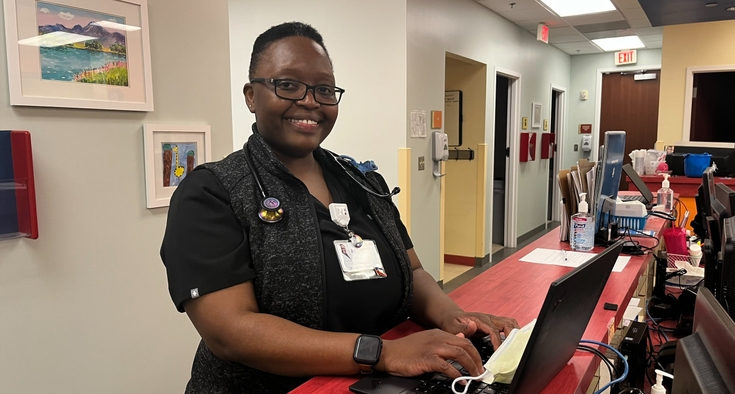Your kid didn’t look like that three hours ago.
Here to talk about rashes — and what to do when one pops up on your child — is pediatrician Dr. Anna Wood of Novant Health Waverly Pediatrics & Primary Care in Charlotte.
Your child deserves the best care.
What is a rash, and why do they happen?
A rash is when the skin looks inflamed or more red than usual. It may also look irritated or have bumps. In people of color, a rash may not appear bright red, but you’ll notice a change in skin tone.
The most frustrating part of rashes is that they can be caused by almost anything: a bacteria, a virus, a fungus, a reaction to starting a new medication, an allergic reaction to something outside, or to something like clothes, detergent, personal care products like lotion or shampoo, or food. You can even get a rash from being exposed to the sun or heat.
How do you know what’s causing a particular rash, then?
History is most important with any kind of rash. Contact dermatitis or an allergic rash can look very similar to a viral rash, but if the parent is saying, “She’s had a fever and a snotty nose, and then she got this rash,” this is very different from, “We tried a new soap brand and it appeared after that.” It’s the history that leads me down each category. And there are a lot of categories to consider! (See the end of this article for more details on the most common rashes and their categories.)
Are some kids more prone to rashes than others?
Yes — there are certain kids who have much more sensitive skin. I think of these as kids who have more “allergic tendencies.” They’re kids with asthma, seasonal allergies, and/or eczema. Their skin reacts a lot quicker because their immune system overreacts to everything.
When I see a rash on my child, what should I do?
Try not to go to Google or the internet. The internet will take you down some very wild rabbit holes.
Instead, take a picture in good lighting of the rash. Our phones are so great because they record the date and time of the picture. If it’s spreading, that can tell us how quickly it’s growing. It’s very helpful to see the evolution or changes of the rash.
Then, you can send that picture and any details you’ve noticed to your child’s pediatrician on MyChart. If the rash goes away, I still appreciate a follow-up message saying it has resolved. With a photo, we might be able to avoid a visit, and if we need one, we can streamline it because I already have an idea of what’s going on.
When should I be worried about a rash?
Any time you are worried, feel free to make an appointment with your pediatrician. But in general, listen to your child about how bothersome it is to them. How they’re behaving says how quickly things need to get done.
I saw a child the other day who had a viral rash that looked awful. It covered him head to toe, but he was playing, running around, eating and drinking well, and had no other real symptoms. In general, if your child is acting fine, but has this terrible rash, you can make an appointment with your pediatrician, but it’s probably not an emergency.
However, if your kid is not acting well, has a fever, and is looking very sick in addition to their rash, it might be time to think about urgent care or an emergency room visit, even if the rash is tiny. In particular, if the rash is very red, hot, swollen and painful to the touch, it could be an infection like cellulitis, which requires same-day medical attention. Go to the emergency room if your child also has a fever and the rash is spreading quickly.
If the rash has been there for a long time and you’ve managed it before (for example, eczema), or if it’s something “expected” (for example, you recently changed detergents or soaps), you can watch and manage them at home. If they don’t get better, come in and see your child's doctor.
What can parents do to prevent rashes?
A lot of rashes are caused by viruses. Some of these viruses (like the dreaded hand, foot and mouth disease) are notorious in a preschool or day care setting, because young children put their hands in their mouth and then touch toys and one another. Remind your kids to wash their hands before they eat, not to share food or drinks with others, and not to touch their face, eyes or mouth. This goes for all ages.
Some viral rashes like varicella (chickenpox), measles and rubella are vaccine-preventable, so vaccinate your child on schedule to avoid these.
Also, if they play a sport, make sure that surfaces and equipment are getting wiped down between uses. I’ve seen patients get rashes from football equipment, wrestling and gymnastics mats, and ballet barres that weren’t cleaned properly. And if they’re showering in a public shower, they should always wear shower shoes.
For teens, some makeup ingredients can cause reactions, so be careful with new products. I tell teens not to share mascara or any liquid makeup that you’re touching with your finger to apply (such as foundation) because these products can harbor a lot of bacteria.
Do you have any special tips for avoiding or treating summer rashes?
- Heat rash is common among babies and young children. The goal is to keep your baby cool with light layers. If you start to see redness or a rash, get them inside and take their clothes off, and it should resolve on its own.
- Teach your kids what poison ivy and poison oak look like and how to avoid them.
- For kids with eczema: air conditioning, chlorine, and the sun can all dry out the skin, so make sure they’re using a really good moisturizer after swimming or being in the sun.
- If your child gets an insect bite or a hot itchy rash, I don’t always recommend topical hydrocortisone or topical anti-itch medicines. Instead, I suggest an ice pack, especially the “gel” packs. Put it on for 5 to 10 minutes and it will cool the rash.
In closing, rashes are understandably very stressful for a lot of families. More often than not, though, they won’t be extremely harmful for kids. There are many things that can cause them, so talking with your doctor will be helpful in determining your next steps.
Let your pediatrician know if you’re worried about anything. We love that we have the technology to be able to send pictures and communicate with you.
The 9 most common rashes Dr. Wood sees in kids
Rashes can be divided into four main causes or categories.
1. Dermatitis (inflammation of the skin)- Contact dermatitis is when skin is itchy, red and irritated from something that it touched. Common triggers include skin care products, poison ivy, grass and nickel, but anything can cause contact dermatitis — it just depends on what triggers that child’s immune system. Treatment depends on your child’s case and its trigger.
- Diaper dermatitis (“diaper rash”) is when a baby or toddler’s urine or bowel movements inside their diaper irritate their skin and cause a reaction. It can be prevented and treated by changing the child’s diaper regularly and applying barrier cream (like Desitin) or emollient ointments (like Aquaphor). Rashes in the diaper area aren’t always diaper dermatitis — they can also be caused be bacterial or fungal infections — so if your child has a diaper rash that isn’t going away, see your pediatrician.
- Atopic dermatitis (eczema) is when the child’s own immune system is causing the rash. These children will often have a red rash, dry skin and will be itchy. I tell parents to apply a lot of very good moisturizer at least two times a day to their child with eczema (I recommend Aquaphor or Vaseline if you like emollients, or Eucerin or CeraVe if you don’t like that greasy feeling). Dry skin will cause them to scratch, which can trigger more eczema flares, and can also open their skin up and cause infection. I also encourage these kids’ families to use fragrance-free lotions, body washes and detergents, because these are less irritating products and are less likely to cause flares.
2. Viral rashes
- Roseola is when the child will have very high fevers for several days. Then the fever goes away and a rash covers the child’s body. It’s usually not painful, and doesn’t actually hurt children, but it can be unsettling. No treatment is needed in the rash phase of the illness.
- Hand, foot and mouth disease is when the child gets a rash and/or painful blisters on their hands, feet, and inside and/or outside of the mouth. There is nothing to do to reduce the rash; parents can treat with pain-relieving medicines like Tylenol or Motrin, and keep their child hydrated.
- Parvovirus causes a “slapped cheek” rash where your child’s cheeks will look like they have just been struck. The facial rash will go away, then the rest of the body will get a rash. They may also get a fever. There is nothing parents should do, besides treat with pain-relieving medicines if needed.
- Impetigo can happen any time there is a break in the skin allowing bacteria to enter and cause infection. It usually happens around the nose, mouth, hands and feet. It looks red at first, then becomes crusty and yellow-colored. We treat it with an antibiotic (either oral or a topical skin cream with antibiotic in it). It can be caused by both staph and strep bacteria.
- Scarlet fever is caused by strep bacteria in a child’s throat. It causes a very fine bumpy rash on their chest, stomach and back (the rash is sometimes described as “sandpaper”). Sometimes the child will have a sore throat, but not always. We treat it with oral antibiotics.
4. Fungal cause
- Ringworm can be confusing because it often looks like a dry patch similar to eczema. However, if you look closer, typically the center of the rash looks smoother and the outside has a raised, scaly border. The child will need topical anti-fungal cream for it, and may even need oral antifungal medication depending on the location. Athlete’s foot and jock itch are two common presentations of fungal infections, but it can be anywhere on a child’s body.















